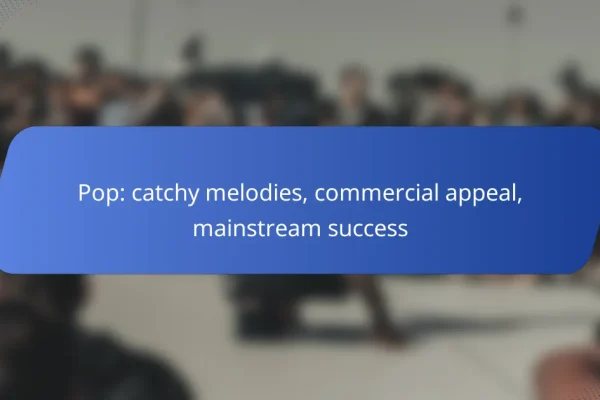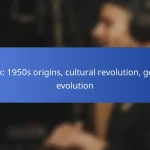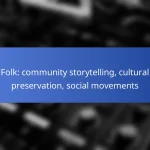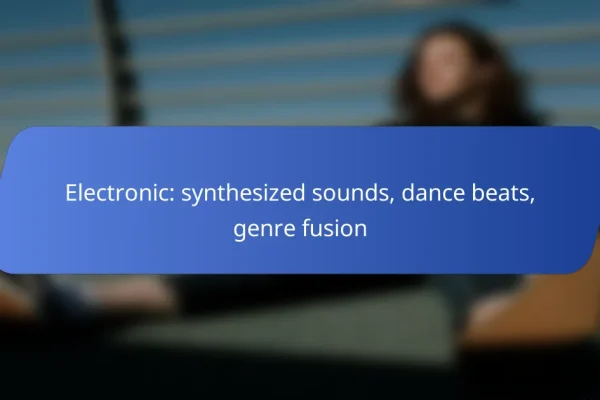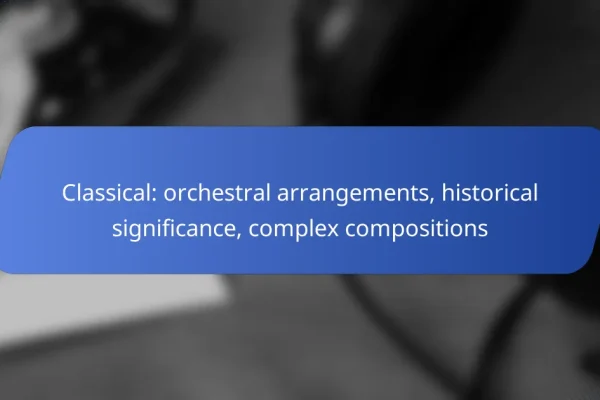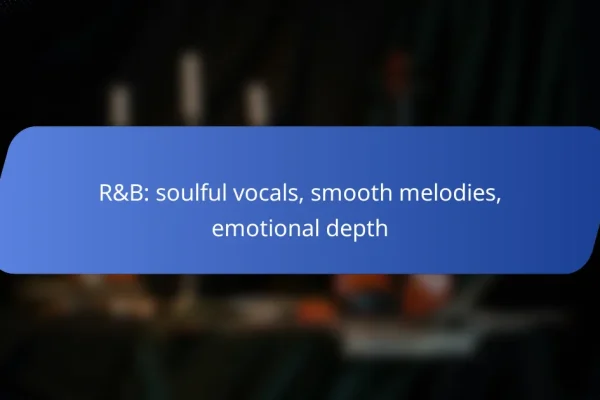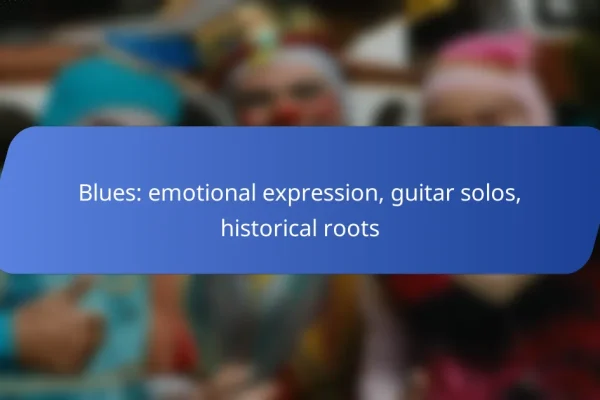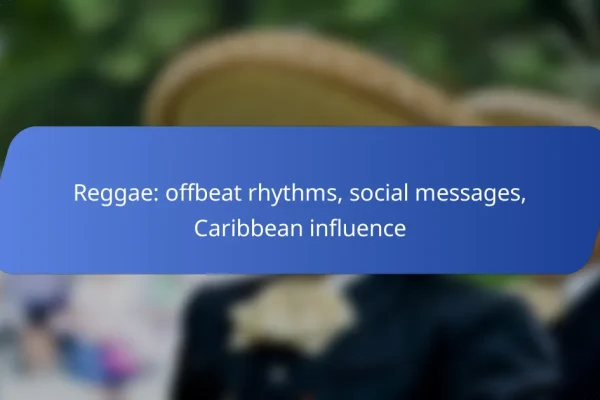What are the popular music styles in Australia?
Australia boasts a diverse music scene with several popular styles, including rock, hip hop, country, electronic dance music, and indie. Each genre has its own unique characteristics and cultural significance, reflecting the country’s rich musical heritage.
Rock music
Rock music has a strong presence in Australia, with a history that dates back to the 1950s. Iconic Australian bands like AC/DC and INXS have shaped the global rock landscape, while local festivals often celebrate both classic and contemporary rock artists.
When exploring rock music in Australia, consider attending live performances or festivals, as they provide an authentic experience of the genre. Popular events like the Big Day Out showcase a mix of established and emerging rock acts.
Hip hop
Hip hop has rapidly gained popularity in Australia, with artists like Hilltop Hoods and Tkay Maidza leading the charge. This genre often incorporates local slang and cultural references, making it relatable to Australian audiences.
To appreciate Australian hip hop, listen to tracks that highlight local themes and collaborate with artists from diverse backgrounds. Engaging with the community through events and open mic nights can also enhance your understanding of the genre.
Country music
Country music is a beloved genre in Australia, particularly in rural areas. The Tamworth Country Music Festival is one of the largest in the Southern Hemisphere, attracting fans and artists from across the country.
Australian country music often blends traditional elements with contemporary sounds. Notable artists like Kasey Chambers and Keith Urban have made significant contributions to the genre, showcasing the unique Australian storytelling style.
Electronic dance music
Electronic dance music (EDM) has surged in popularity in Australia, with vibrant scenes in cities like Sydney and Melbourne. Major festivals such as Stereosonic and Beyond The Valley feature both local and international DJs, drawing large crowds.
When exploring EDM, pay attention to the various sub-genres, including house, techno, and trance. Engaging with local clubs and events can provide insight into the evolving EDM culture in Australia.
Indie music
Indie music thrives in Australia, characterized by its DIY ethos and diverse sounds. Many Australian indie bands, such as Tame Impala and The Jungle Giants, have gained international recognition while maintaining a strong local following.
To discover new indie music, explore local venues and online platforms that promote emerging artists. Participating in music festivals that feature indie acts can also help you connect with the vibrant Australian indie scene.
How do music styles influence Australian culture?
Music styles significantly shape Australian culture by reflecting its diverse population and fostering community connections. Various genres, from Indigenous music to contemporary pop, create a rich tapestry that influences social interactions and cultural expressions across the country.
Reflection of diversity
Australia’s music scene is a vibrant reflection of its multicultural society. Genres such as hip-hop, country, and Indigenous music showcase the wide range of backgrounds and experiences present in the population. This diversity not only enriches the music itself but also promotes understanding and appreciation among different cultural groups.
For example, festivals often feature a mix of musical styles, allowing audiences to experience various cultural traditions. This blending of genres encourages collaboration and innovation within the music community.
Impact on local festivals
Local festivals in Australia are heavily influenced by the country’s music styles, often highlighting regional sounds and artists. Events like the Woodford Folk Festival and the Big Day Out celebrate a variety of genres, drawing crowds from across the nation and beyond. These festivals serve as platforms for emerging artists and established musicians alike, fostering a sense of community and shared experience.
Moreover, festivals often include workshops and discussions that educate attendees about the cultural significance of different music styles, further deepening their appreciation and understanding.
Connection to identity
Music styles in Australia play a crucial role in shaping personal and collective identities. For many Australians, specific genres resonate with their cultural heritage, allowing them to express their backgrounds and values through music. This connection can be particularly strong among Indigenous communities, where traditional music serves as a vital link to ancestral stories and practices.
Additionally, contemporary Australian artists often draw on their cultural roots, blending traditional elements with modern influences. This fusion not only preserves cultural heritage but also creates a unique Australian identity that is recognized globally.
What are the characteristics of different music styles?
Different music styles are defined by unique characteristics that influence their sound and emotional impact. Key elements include rhythm and tempo, instrumentation, and lyrical themes, each contributing to the overall identity of a genre.
Rhythm and tempo
Rhythm and tempo are foundational aspects that shape a music style’s feel. For example, genres like hip-hop often feature a strong, steady beat with a moderate tempo, while electronic dance music (EDM) typically has a faster pace, encouraging movement and dancing.
When analyzing rhythm, consider the use of syncopation, which adds complexity and interest. Jazz often employs syncopated rhythms, creating a laid-back yet dynamic feel that distinguishes it from more straightforward genres like pop.
Instrumentation
Instrumentation refers to the specific instruments used in a music style, which greatly influences its sound. For instance, rock music commonly features electric guitars, bass, and drums, while classical music utilizes a wide range of orchestral instruments, including strings, woodwinds, and brass.
Understanding instrumentation can help you appreciate the nuances of each genre. For example, folk music often highlights acoustic instruments like the guitar and banjo, creating an intimate and organic sound that contrasts with the polished production of mainstream pop.
Lyrical themes
Lyrical themes encompass the subjects and messages conveyed in a song, which can vary widely across music styles. Country music frequently explores themes of love, heartbreak, and rural life, while punk rock often addresses social issues and rebellion.
When examining lyrical content, consider the cultural context. For example, reggae music often reflects themes of social justice and unity, rooted in the historical experiences of the Jamaican people. This connection to culture can deepen your understanding of a genre’s significance.
How to choose a music style for your project?
Choosing a music style for your project involves understanding your audience, the mood you want to convey, and the message you aim to communicate. These factors will guide you in selecting a style that resonates effectively with your goals.
Identify your audience
Understanding your audience is crucial when selecting a music style. Different demographics respond to various genres; for example, younger audiences may prefer pop or electronic, while older listeners might lean towards classic rock or jazz.
Consider conducting surveys or focus groups to gather insights about your target audience’s preferences. This can help you tailor your music choice to better engage them and enhance their overall experience.
Consider the mood
The mood of your project significantly influences the music style you should choose. For instance, upbeat and energetic music works well for promotional videos, while softer, ambient sounds are more suitable for relaxation or meditation content.
Think about the emotions you want to evoke. Creating a mood board with examples of music that fit your desired atmosphere can help clarify your vision and guide your selection process.
Evaluate the message
Your project’s message should align with the music style you choose. For example, if your project promotes sustainability, using acoustic or folk music may enhance the authenticity of your message.
Ensure that the lyrics, if applicable, and the overall tone of the music support the narrative you want to convey. This alignment will create a cohesive experience for your audience and reinforce your project’s objectives.
What are the emerging music trends in Australia?
Emerging music trends in Australia reflect a blend of local culture and global influences, showcasing a variety of genres and styles. Key trends include the rise of electronic music, a resurgence of indie rock, and the incorporation of Indigenous sounds into mainstream music.
Rise of Electronic Music
Electronic music has gained significant traction in Australia, driven by festivals and a vibrant club scene. Artists are experimenting with genres like house, techno, and drum and bass, often blending them with local sounds to create unique tracks.
Major cities like Sydney and Melbourne host numerous electronic music events, attracting both local and international DJs. This trend is supported by platforms like Spotify and SoundCloud, where emerging artists can share their work and reach wider audiences.
Resurgence of Indie Rock
Indie rock is experiencing a revival in Australia, with many new bands gaining popularity. This genre often emphasizes authenticity and artistic expression, appealing to audiences seeking something different from mainstream pop.
Local festivals such as Laneway Festival and Splendour in the Grass showcase indie rock acts, providing a platform for up-and-coming artists. Many indie bands are also leveraging social media to build their fanbase and promote their music.
Incorporation of Indigenous Sounds
There is a growing trend to incorporate Indigenous Australian sounds and themes into contemporary music. Artists are blending traditional instruments and storytelling with modern genres, creating a rich tapestry of sounds that resonate with diverse audiences.
This movement not only celebrates Indigenous culture but also raises awareness about social issues. Collaborations between Indigenous and non-Indigenous artists are becoming more common, fostering a greater appreciation for Australia’s musical heritage.
